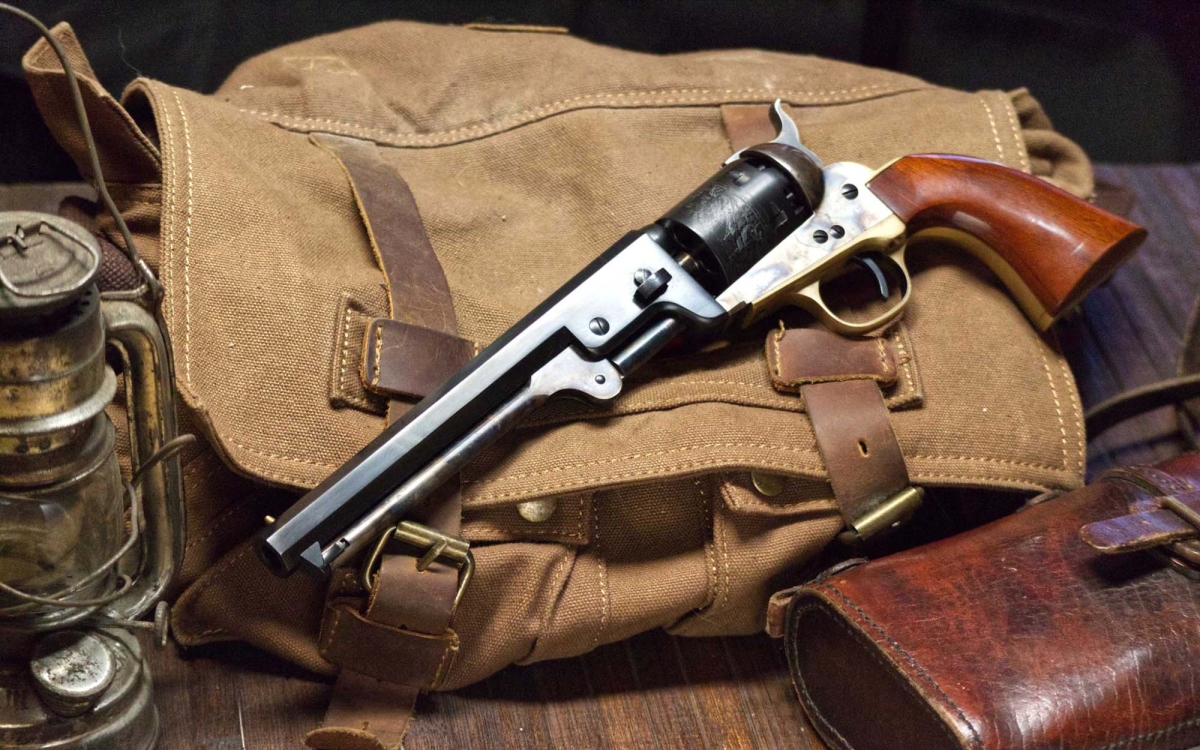Black powder: preloaded spare cylinders in cap and ball revolvers
Among black powder cap and ball revolvers enthusiasts it happens sometimes to hear that soldiers during the American Civil War carried preloaded, spare cylinders for their revolvers for fast reloading, much like with modern times speed loaders. True or false?
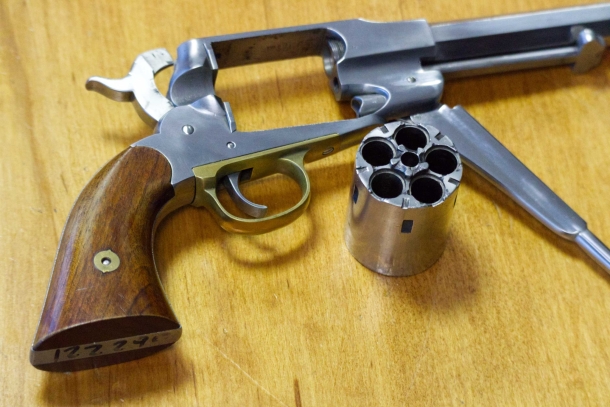
Though a cartridge conversion (like that used by Clint Eastwood in Pale Rider) we can observe the way the cylinder can be removed with relative ease from the revolver. (Original from Uberti’s collection)
The practice of using preloaded, spare cylinders for fast reloading a cap and ball revolver has even been portrayed in movies (such as Clint Eastwood’s The Pale Rider) but, as always, we should be wary of what we see in movies.
While it is surely possible to do so from a merely technical point of view, and therefore there’s no way to positively exclude somebody did it in one way or another, to get to the bottom of the issue we should not just focus on single specific aspects of the matter, but rather have a look at it in its entirety, both from the point of view of original sources, and empyrically.
Let’s start with the sources: almost all references to the practice of carrying preloaded spare cylinders are from XX century secondary sources. But we know how hearsay may be reported as fact, or a tale repeated until it became fact in secondary sources, so I’m extremely wary of them.
Armies have always been fond of inventories and detalied recordings of every item issued, down to the last handkerchief and safety pin. This has very solid reasons: giving someone a safety pin may be considered a trifling matter not worth mentioning but issuing a safety pin to each of 100.000 soldiers becomes an issue of strategic raw material consumption and usage of large sums of money, which has to be strictly tracked, every single pin to be accounted for.
Guns and their components are far more expensive than safety pins, so, upon the end of the American Civil War, the War department received a request by the US Congress to provide an inventory of ordnance materials purchased by the Federal Army during the war, to allow investigations on contracts and purchases. The inventory was published in 1867 as Executive Document 99 of the 40th Congress, Second Session.
This document has no mention whatsoever of spare cylinders being issued to troops. If they had been, they would have most definitely been recorded.
On the other hand we know of large amount of spare parts (particularly cylinders) made, which were later used for cartridge conversions such as the Richards-Mason. Could be that these were at some point construed as “spare cylinders” to carry for fast reloading, as it had been sometimes made with Colt Patersons?
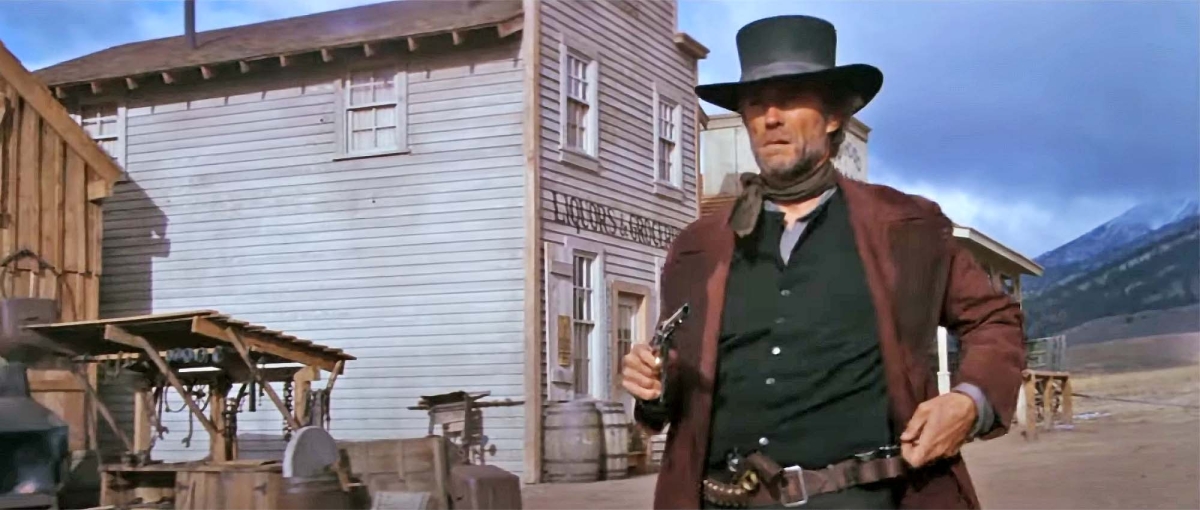
The scene in "Pale Rider" (1985) where Clint Eastwood swaps loaded cylinders in his Remington 1858
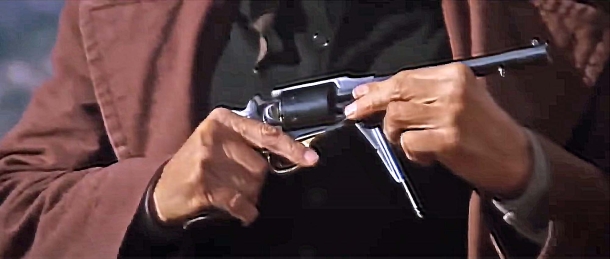
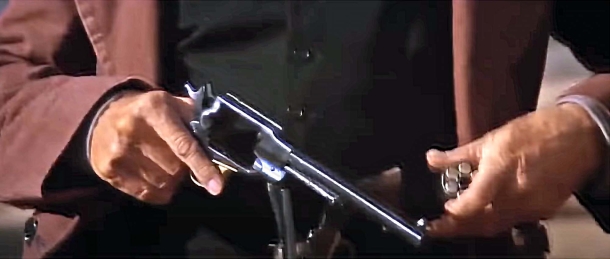
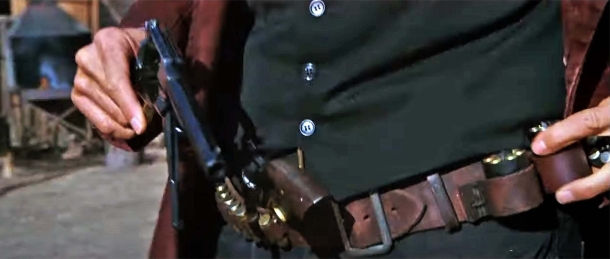
Details from "Pale Rider" (1985)
The revolver employed was an Uberti Remington 1858 replica, with cartridge conversion for scenic reasons. We can notice the cartridges in the bored through cylinder and the spare cylinders in the belt pouches: an impractical solution with breechloading cylinders, given the ease with which cartridges could be jostled out of the chambers accidentally...
To swap the cylinder on a Navy one needs to disassembly the gun and juggle barrel, frame, the empty cylinder and the loaded one. Now imagine doing it on a skittish horse on a battlefield.
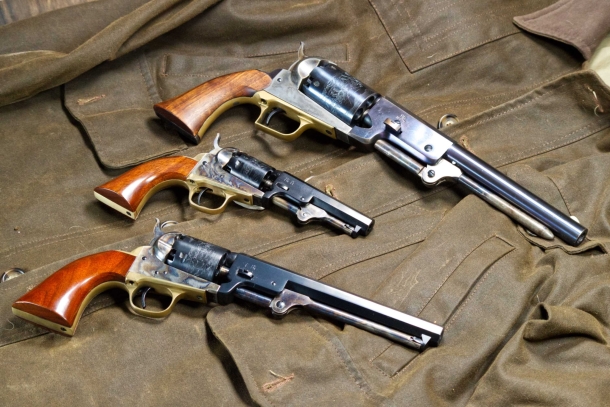
With two Colt Walkers (or more likely Dragoons) in the saddle holsters, two Colt Navy revolvers in your belt and 2-3 Colt Pockets in the pants or coat, available volume of fire was impressive.
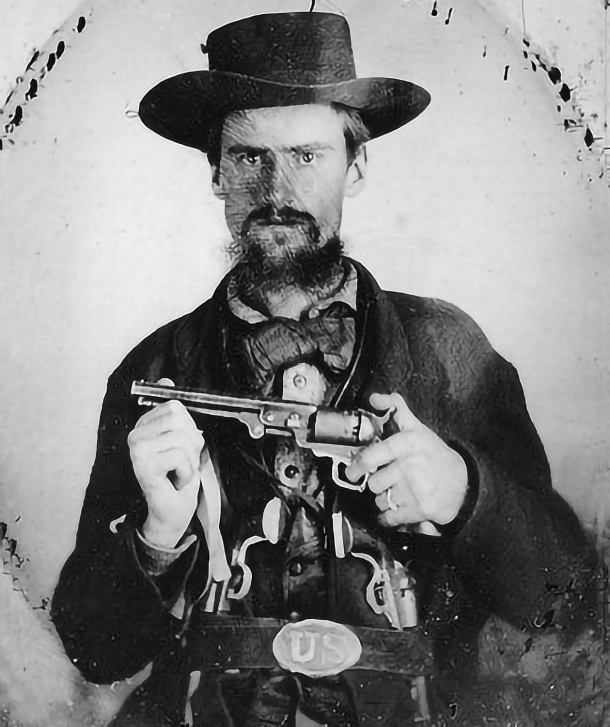
John Jarrette, with Quantrill's Raiders first, then in the infamous "Younger Gang", with two revolvers in the belt and one in the hand. Probably at least two more would be carried in saddle holsters.
If carrying one or more spare cylinders had been common practice, we should find trace of it in original (primary) sources: it all happened just 160 years ago in an era were detailed bookkeeping and reporting were already commonplace, logistics were strictly organized and armies were fond of their bureucracies at least as much as the state was.
Manufacturers kept registers as well and, also very important, a lot of people kept diaries.
If swapping preloaded cylinders had been a thing, revolvers would have been routinely issued with more than one cylinder. While this had been done with the Paterson (and there is mention of people using preloaded Paterson cylinders), the practice was discontinued and there's no trace of Colt or Remington Civil War time revolvers being routinely issued with more than one cylinder in either manufacturer's or military records.
Some cased specimens were sold with a spare cylinder, but cased guns are something very different from issue guns.
We don’t know of multiple “spare” cylinders found in military storage or on battlefields. There's no mention of them in military reports, diaries, letters written by soldiers, or other direct source, nor in any cavalry manuals.
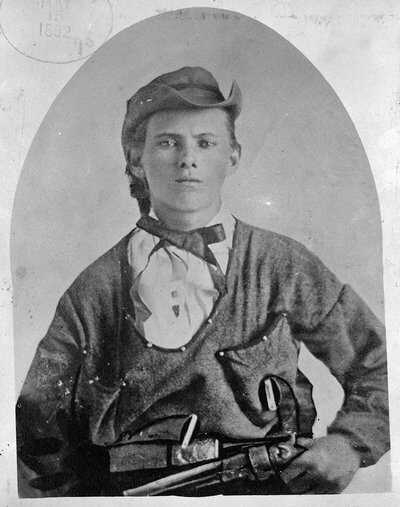
Legendary Jesse James, in this picture with no less than three "belt" revolvers. Then there were the pocket ones.
Quartermaster records and manufacturers spare parts lists, unit inventories of weapons and their paraphernalia, reports of unit inspections of soldiers' equipment, issuance / return records and receipts do not have any mention of spare cylinders, nor do records about captured soldiers and their arms.
The only mention of cylinder swapping for reloading is the case of the Pony Express (specifically Billy Tate).
Pony Express equipment was designed in every detail to minimize weight. It would have been reasonable to carry a second, loaded cylinder rather than a whole gun.
But even this I found on secondary sources, so I’m wary of that as well and, apart from this, nobody mentions the routine use of spare, loaded cylinders.
Is it even possible to do so? Theoretically, yes, sure.
But what we should instead ask is: would it have been useful, or reasonable?
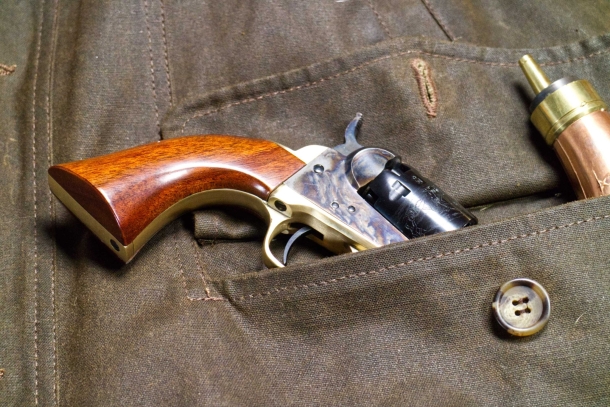
Clothing of the time had large pockets, where it was very easy to make a small Colt Pocket 1849 and it's ammo disappear
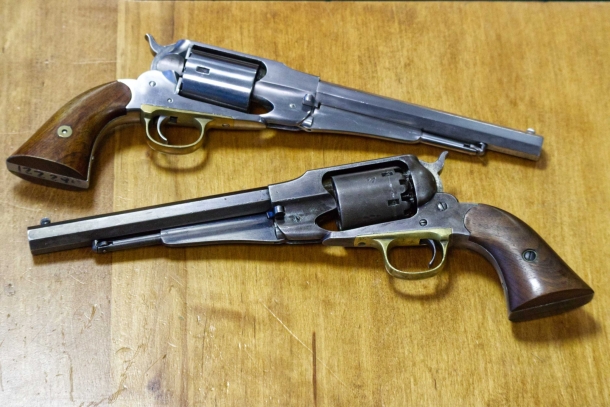
Two original Remington 1858; in the cartridge conversion (above) and in the cap and ball one the cylinder can be extracted in the same way. (Uberti's collection)
A loaded and capped cylinder: one can easily see how unwise carrying one this way could be. Also, should it fall, it could be as dangerous as a grenade
Well, here is the first drawback of carrying preloaded cylinders: it’s like carrying a pocket claymore mine. Not very safe. Imagine the cylinder being bumped hard, or dropping it on the ground... from horseback... Colt instruction sheet provided with each revolver explicitly recommended “The cylinder is not to be taken off when loaded”.
And here's the second drawback of the whole concept: revolvers were issued to cavalry units. Imagine having to juggle empty cylinder, loaded cylinder, cylinder pin and the revolver itself while holding the reins of a constantly jumpscared horse on a battlefield.
Actually, most regular units weren't even supposed to reload: you charged the enemy, firing your revolver as you closed, then swapped it with your saber and used it in the clash. This wasn't done because of armies' traditionalism: it was the smart thing to do if you wanted to survive in a close quarter clash, where shooting a friend in the chaos of the melee would have been all too easy, while a gun would not have been worth much for parrying saber slashes.
Manufacturers did make some guns with a spare cylinder, so this could be an indicator that some did swap preloaded cylinders… or is there a simpler, more reasonable explanation?
Well… first, all guns I’ve seen fitted with an extra, spare cylinder were fitted with one spare cylinder. Now, if I wanted a gun fitted with extra cylinders to use them for reloading, I would want several of them, not just one. Just one looks more like a spare to have handy for contingencies.
Second, there are far simpler reasons to have a spare cylinder than using it as a preloaded “speed loader”, such as for example:
- Having a spare if the main one had an issue, like it broke (Walkers probably did leave a bad track record about cylinder reliability…) or the gun got dunked in water and the charges got wet. Instead of having to send the gun to have a spare fitted, or having an inoperable gun until you managed to draw the wet charges, you swapped the inoperable cylinder with the spare one and your gun was back into action.
- Having your gun back in action ASAP while doing maintenance in situations where you had some time but weren’t completely safe: cleaning the cylinder is the most time consuming operation in revolver maintenance, so you quickly cleaned bore and frame, assembled the gun with the spare cylinder and then took your time cleaning the used one.
Some irregular units, in their particular kind of warfare, did rely much more on revolvers, but even them didn't carry spare cylinders, they did something much smarter: like the Texas Rangers years before, who were officially issued two Walker revolvers each, most irregulars, like Quantrill's Raiders, carried at least two revolvers, and some went as far as carrying four or five: on saddle holsters, on the belt, some smaller models (such as the extremely popular Colt Pocket) tucked away in their pants or in the pockets of their overcoats.
When a gun was empty, they just grabbed a loaded one: much faster, safer and effective than swapping loaded revolver cylinders on horeseback in the middle of a battle. Moreover, should a gun get bound by powder residue or a cap fragment falling into the action (which happened, even if not as frequently as many think), a spare gun would have been much more useful than a spare cylinder.
So, while the idea of swapping spare cylinders on a cap and ball revolver may seem a smart move from a theoretical point of view, or at the range, we may reasonably say that it wasn't usually contemplated in the reality of the battlefield: carrying multiple revolvers definitely was. Could someone have done it? Surely. But in light of everything said, we must conclude that it just doesn’t seem to have been common practice.
Many of those who carried a revolver at those times weren't "gun experts" from a modern, technical standpoint, but they were experts in the use of firearms in life and death situations: if they carried two or more revolvers, and not spare cylinders, probably that was the best choice, as fascinating as the other one may look today.



